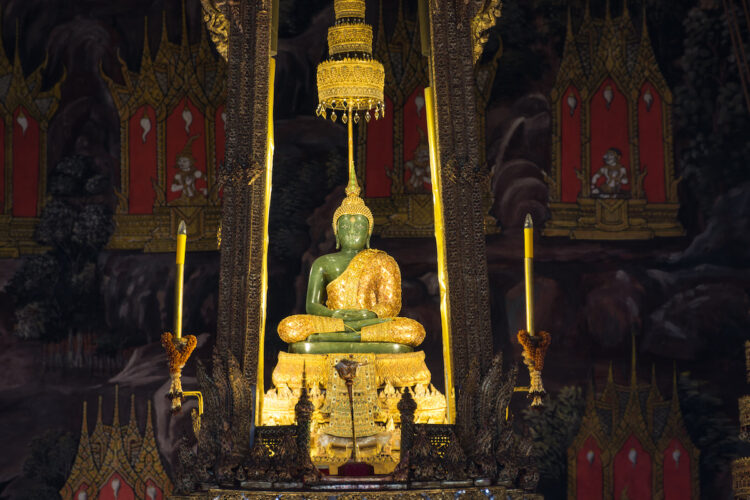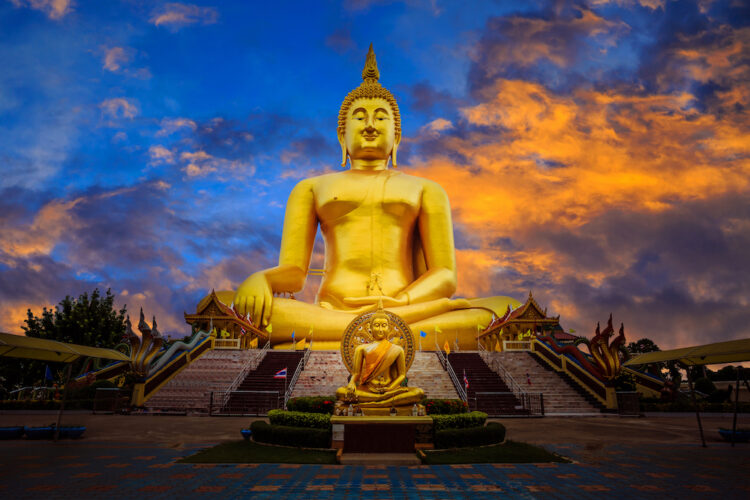Bangkok is a city that reveals itself one street, one alley, and path at a time. After two weeks, I continued to venture further each day, walking and taking tuk-tuks to different sections of the city, keeping my bearing by knowing where the Chao Phraya river was situated relative to my location at all times. The Chao Phraya was my main transportation route each day as I visited by water taxi the many temples in the city in a quest to see the city and acquaint myself with its twists and turns. I was on my own for a longish weekend without a guide, and I was in search of Buddhas. Not THE Buddha, but some of the amazing statues of the Buddha situated in the “wats,” or Buddhist temples, in the city.

It takes only a few minutes in Bangkok to be awash in the Buddhist culture everywhere present, visible in the city’s temples, spirit houses, and yellow and orange-robed monks. More than 95% of the population is Buddhist, and almost every male Thai is a monk for at least some brief period of their life before the age of 20, typically for 2 – 3 months. Nationwide, there are more than 30,000 temples in Thailand and many of these house monks. Buddhism arrived as early as 250 BC and mixed with animistic Chinese beliefs. The Thai King is the primary patron of Buddhism and the monarchy inextricably intertwines with belief.
The historical Buddha lived 500 years before Christ in Nepal and was born with the name Siddhartha Gautama into a royal family. There are many, many, many Buddha images in Bangkok, too numerous to count but absolutely a wonder to experience. Here are my top four, the ones that now travel with me as I think back to the time I spent in Bangkok.
The Emerald Buddha
On my first visit to Bangkok, almost 20 years ago, I visited the temple Wat Phra Kaeo, the Temple of the Emerald Buddha located inside the walls of the Grand Palace. The Temple is situated on the eastern bank of the Chao Phraya River. Though the Royal Family no longer lives in the Grand Palace, many official state functions and ceremonies are still held on the grounds. The Emerald Buddha is Thailand’s most revered Buddha image and many legends surround its history, beginning in 1434 when, according to the story, lightening hit a tree in a northern province near Chiang Rai and the Buddha was found inside the tree coated in stucco which peeled off to reveal an emerald green jade statue.

Shoes are removed as visitors to the wat enter the room with the diminutive statue set high on a pedestal. Worshipers kneel or sit quietly before the Buddha image. Appropriate dress is important, and shorts, tights, singles, sweatshirts, and fisherman’s trousers are not allowed. It is important never to point at a Buddha image with your feet. Shoes are removed as you enter the temple. With the exception of the King or another member of the Royal Family, no one is allowed to touch the statue. The clothing is changed by the King of Thailand three times a year in a venerable, sacred ceremony.
The Great Buddha
My original plan was to visit the most interesting Buddha images in Bangkok, but realized only two hours away was Thailand’s largest Buddha. What I hadn’t counted on was the series of hops it would take to cover the distance. The Great Buddha is located in Wat Muang in Ang Thong province north of Bangkok, and if you have your own transportation, two hours is close to correct once you are free of the traffic-snarling roadways of Bangkok. I, however, was without personal transportation and had to rely on a mini-bus from Monchit Terminal to a bus terminal in Ang Thong. From there, you can take a tuk-tuk or a motorbike to Wat Muang.

On the approach to Wat Muang, in the rural countryside, the Great Buddha towers in the sky, 93 meters tall. Started in 1990, the Great Buddha took 18 years to construct. The surrounding temple complex is large and contains a market and food stalls. Steps at the base of the statue allow visitors to touch the image’s right hand for good luck.
Around the Buddha is “Hell Garden” featuring statues of gods, souls, and demons from Buddhist Hell. Graphic depictions of torture and punishment, with half-human creatures and people being cooked in the fires of Hell, tongues ripped out or suspended above the flames make for a cheery memory. It was my first exposure to this side of Buddhism which I had always imagined as somehow more peaceful and tranquil than the hell-fire and brimstone images I carry from my Southern Baptist childhood in North Carolina.
The Golden Buddha
In 1954, a building was constructed at Wat Traimit to house a plaster stucco Buddha statue that weighed an incredible 5.5 tons. As workers hoisted the statue to work around it, the ropes broke, and the massive Buddha fell to the ground. Instead of shattering, however, the plaster parted from the solid gold Buddha hidden underneath.

Almost 10 feet tall, the statue is assembled in nine separate sections which fit tightly together.
A key at its base allows the statue to be disassembled for transport. Not much is known of its actual history prior to the discovery of its true nature. It is believed to have been cast in the 13th Century. The Buddha sits cross-legged, with one hand reaching down in the “touching the earth” posture. During its history, it survived many factious invasions and while other statues were being stolen, the stucco coating of the Gold Buddha concealed its value and secured its return to Bangkok from the countryside.
The Reclining Buddha
In Wat Pho, just behind the Temple of the Emerald Buddha is a giant Buddha, laying on its side, its arm holding its head up as though lounging on the dais. The statue’s posture symbolizes the Buddha’s entry into Nirvana and the end to the cycle of death and re-birth, the end of suffering. Covered in gold leaf, the statue is massive, 46 meters long and 15 meters tall. The feet of the great statue are literally imprinted. 108 bowls line the walls, and visitors drop coins in the bowls to obtain karmic merit, the resulting noise of the coins falling against the bowls echoing in the large room.

Wat Pho, the temple housing the Reclining Buddha, is one of the oldest temples in Bangkok and is also a public school, specializing in religion and science. Here, too, is a school for Thai massage and visitors can obtain a skilled session on the spot, though there is often a wait. The main temple structure is surrounded by smaller chapels. There are more than 1,000 Buddha images at Wat Pho, more than enough to satisfy my search for the Buddha during my short Bangkok stay.
